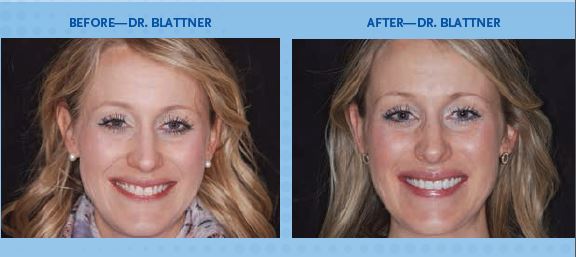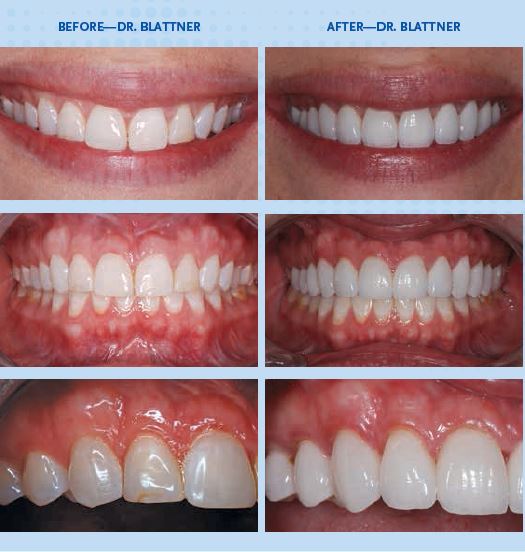
The Dentist as Patient and the Patient as Dentist.
For the past 40 years, the Dr. Dick Barnes Group has offered seminars to thousands of dentists. The following article was written after a Clinical Hands-On course taught by Denver-based dentist, Dr. Jim Downs. The four-day course, held over two weekends, is designed to give dentists the highest level of training in advanced cosmetic techniques through a clinical, hands-on experience. During the course, a full maxillary arch is reconstructed—from prepping to seating.
In 2014, two dentists who attended the course were also the volunteer patients for the course. The participants were Dr. Michael B. Beeler, a dentist from Tennessee in practice for about 40 years, and Dr. Ashley Blattner, a dentist from Missouri in practice for about six years. Both dentists shared their perspectives on the experience with Aesthetic Dentistry. Here are highlights:
Dr. Michael B. Beeler, D.D.S.
In the past several years, I have taken Over the Shoulder™ courses on cosmetics, implants, occlusion, and the Total Team Training course with the Dr. Dick Barnes Group. I’ve also used Arrowhead Lab for crowns and veneers for my patients. So after contemplating “remodeling” my mouth, I volunteered as a patient for the Clinical Hands-On course with the Dr. Dick Barnes Group.
I called Peggy Nelson at Arrowhead, and she asked me to send photos, radiographs, and study models of my teeth and mouth, to determine if my case met the course requirements. In addition to volunteering as a patient, I also wanted to participate as a dentist. I hoped that another dentist and I might take turns as patient and dentist for a full arch reconstruction.
After a few months, Arrowhead called to tell me that they found a dentist, Dr. Ashley Blattner, who wanted to take the Clinical Hands-On course, but she needed a patient.
Dr. Blattner had graduated from dental school about three or four years prior and was practicing in Missouri.
It worked out great! During the course, I volunteered as Dr. Blattner’s patient for a full upper arch reconstruction and Dr. Blattner was my patient for a full upper arch reconstruction.
How It Began
Prior to the course, Peggy suggested that Dr. Blattner and I call each other to discuss the procedures. After a couple of emails and phone calls, Dr. Blattner and I met in October 2014 at Dr. Jim Downs’s office in Denver, CO, just prior to the course. An additional five or six dentists attended the course with their respective patients.

I wasn’t worried about anything because Dr. Downs is an experienced dentist and I knew he would guide the procedures. In addition, another esteemed dentist, Dr. Brian Britton, from Arlington, TX, assisted Dr. Downs with the course. Both dentists are great teachers, mentors, and leaders in our profession.
The Patient Experience
Day One (First Weekend): On the first day, I was the patient. Everything was a breeze! I had some old anterior crowns on my upper incisors and gold inlays on my molars. I also had some recurrent decay underneath some of the old dental work.
Dr. Blattner went to work and shaped precise preparations using “prep guides” from Arrowhead Lab, and then used the DENTA™ 2 laser (micro-pulsed CO2) to contour my gingiva and “frame my new smile.” She made and finished the most beautiful temporary crowns possible using great materials, modern technology, and Arrowhead Lab’s technique.
As a patient, I experienced absolutely no postoperative pain from the lasing, the injections or the preps, or from holding my mouth open for several hours. I took no pain medication, and I felt great with my new smile! There were no surprises with my temporaries because they looked exactly like the wax-ups that had been fabricated before the procedure. Day one was great! Dr. Blattner expressed a feeling of accomplishment and some relief that she had prepped and temped a big case.
The Dentist Experience
Day Two (First Weekend): On the second day of the seminar, it was my turn to work on Dr. Blattner. At the time, Dr. Blattner was four months pregnant, so naturally, she was somewhat concerned about having extensive dental work done.
Dr. Blattner’s obstetrician gave the “okay” for her to have dental work done and Dr. Blattner’s only request was that we only use local anesthetic without epinephrine. I thought, ‘No problem.’ But I was wrong.
Shortly after beginning the procedure, I became concerned because Dr. Blattner’s teeth were sensitive and she had difficulty staying numb for more than about ten minutes. It was a big case and I was becoming frustrated about getting behind schedule.
Dr. Downs reminded me that when a woman is pregnant, it is normal for the body to more quickly metabolize anything that it might perceive as foreign in order to better protect the unborn baby and the mother.
The “over-the-patient” delivery system and the control buttons on the chair were different from ones at my office. I wasn’t in the familiar comfort zone of my “behind-the-patient” delivery system and I actually began to get nervous about finishing Dr. Blattner’s preps in a timely fashion. I had only brought with me 2.5X loupes, and 3X or greater are really needed for this kind of precision dentistry. I was the oldest dentist there, I had completed hundreds of full arch cases, and I felt that I should have managed my patient’s comfort level better because of my experience. (However, you are never too old to learn!) It seemed as if I could never get into a rhythm and I have a renewed respect for epinephrine in local anesthetic.
Dr. Blattner had several old composite restorations that needed to be replaced. She also had old bonding that was done to close diastemas in between her centrals, and bonding to enlarge small lateral incisors. In addition, Dr. Blattner had an overjet of 5 mm, was slightly overclosed, and is a tongue thruster—therefore, she was not a typical wear case.
Dr. Blattner’s Shimbashi was 15 mm. We needed to improve on her zenith, and therefore planned to end up at a tissue-adjusted Shimbashi of 17 mm. The treatment plan consisted of a full arch reconstruction and future lower arch reconstruction. A wax-up was completed (for more information on wax-ups, see Dr. Jim Downs’s article, “White Wax-Up 101,” Aesthetic Dentistry, Spring 2016).
Case Preparation and Execution
Other than the sensitivity, everything went smoothly with the prep design. We were able to stop the lingual margin on the pre-molars and first molars about 1 to 2 mm shy of the gingiva. The second molars were prepped for porcelain onlays, as requested by Dr. Blattner. The Sil-Tech® stent, made from her wax-up, was used to fabricate her temporary restorations, and they looked great. After adjusting her bite, she seemed very pleased.
Throughout the process, both Dr. Blattner and I were under the watchful eyes of Dr. Downs and Dr. Britton. As I prepped Dr. Blattner (and re-anesthetized her every ten minutes or so), I noticed she was becoming fatigued and I was becoming discouraged.
About the same time, Dr. Downs came to the rescue. He re-contoured the preps (as needed) and his highly skilled and experienced dental assistants (Yvette, Casey, and Ciara) helped with the impression taking and fabrication of beautiful temporaries.
On the Monday after the course, I followed up with a phone call to Dr. Blattner’s Missouri office to see how she was doing. Dr. Blattner said that she was doing just fine. She was excited about her beautiful new smile and was looking forward to getting her permanent veneers, crowns, and onlays.
Six Weeks Later
Day One (Second Weekend): The second part of the course took place six weeks later. On the first day, Dr. Blattner removed my temporaries and put in my new crowns. Dr. Downs checked the fit and they were all perfect! After cleaning the excess cement, my bite was very close to perfect—enough so that I comfortably waited until the next day to check my bite with the T-Scan®.
I was so impressed with the results of my beautiful smile and how my own bite felt that as soon as I got back to my office, I ordered Orascoptic’s wireless adjustable 3X/4X/5X loupes, the DENTA™ 2 CO2 laser from GPT Dental, two curing lights from Ivoclar, and the T-Scan® so that I could immediately incorporate them into patient care.
Day Two (Second Weekend): The second day of the course was spent on seating and using the T-Scan® to check our occlusions. Both our cases needed minor adjustments. I was really amazed at how important the T-Scan® is in providing excellent patient care.
Dr. Blattner’s case went well. Once again, she had some sensitivity due to local anesthesia constraints, and she had some mild bleeding due to pregnancy-induced gingivitis, but her case fit perfectly and her new smile is gorgeous!

We removed Dr. Blattner’s temp crowns fairly easily. However, her tissue was puffy and slightly inflamed due to her pregnancy, and controlling bleeding in the anterior region was a must. After trying in the crowns and veneers, we began the cementation process. At the try-in, all restorations fit perfectly. We used a rubber dam technique, and occlusal T-Scan® adjustments were minimal.
Dr. Blattner seemed very pleased with the final result. For over ten years I have prescribed Elite porcelain crowns, veneers, and cast restorations for my patients. The quality and artistic expertise that goes into each case is exceptional and always appreciated by patients. Of course, Dr. Blattner’s restorations and beautiful new smile looked fantastic. The results made me proud to know that she had the best possible restorations using the latest materials and technology, all with the help of elite Arrowhead technicians.
Reflections
I have been in private practice for more than 40 years. After participating in the Clinical Hands-On course, I am more excited and invigorated than ever before about becoming a better dentist for my patients. My only regret is that I didn’t take this course ten years ago.
Now, I plan on practicing dentistry for an additional ten years so that I can have ten more years of providing the best dentistry to my patients. I enjoy using my wireless Orascoptic adjustable loupes, the DENTA™ 2 CO2 laser, the T-Scan®, and two Bluephase curing lights from Ivoclar, as well as utilizing the techniques that I learned to deliver a higher level of care to my patients.
Dentistry is one of the few professions in which we can visibly change and improve people’s lives. Comprehensive full arch and full mouth reconstruction is not something that all of my patients necessarily need or want. However, it is something that I can now do more confidently and recommend for those patients who come to my office and choose me for their dental care.
I am now truly “invested.” I am more confident and empowered, and I believe that the odds of me being a more successful dentist have increased dramatically as a result of this positive experience. Now I tell my patients, “Just look at my smile!”









